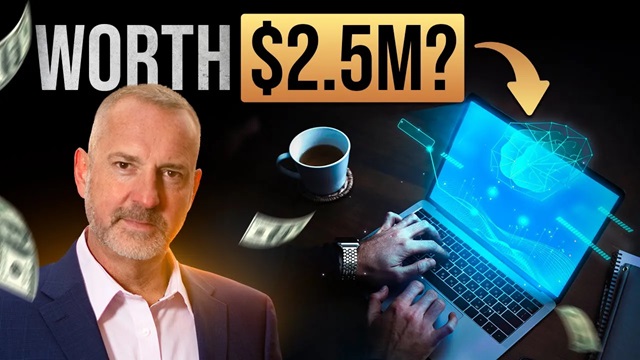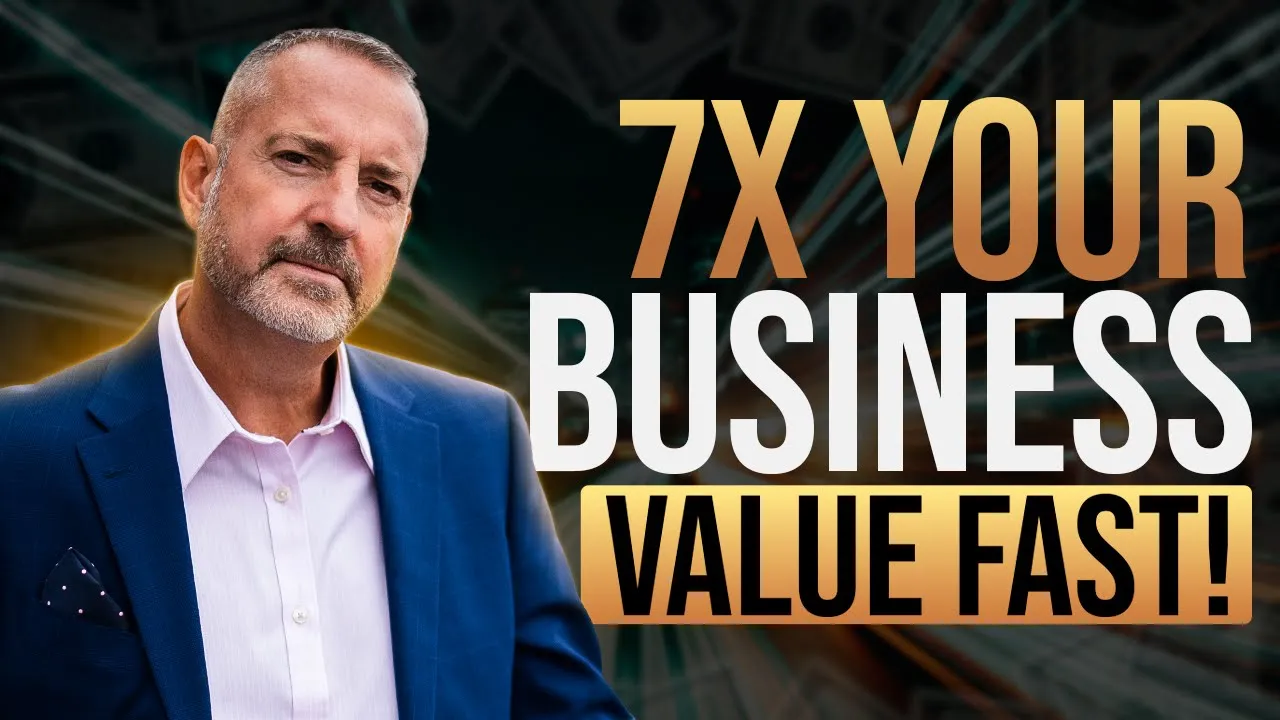Turning Crisis into Opportunity: Why Recessions Are Golden
Turning Crisis into Opportunity: Why Recessions Are Golden
Carl shares real-world stories of entrepreneurs who not only survived massive economic shifts like COVID, but actually thrived by pivoting fast, getting creative, and leaning into the power of differentiation. From manufacturing ventilator parts to turning a rural Italian restaurant into a booming takeout business, this episode is packed with inspiration and proof that tough times create the best opportunities for savvy dealmakers.
If you’re thinking about buying a business and worried about timing—especially with the market looking shaky—this is your sign to lean in, not back. Carl shows how recessions unlock lower valuations and way more flexible deal structures, especially when you focus on value, service, and speed over just price. It’s not about competing with Amazon or racing to the bottom—it’s about finding ways to stand out and solve real problems. This one’s a masterclass in mindset, creativity, and making moves when others freeze. Let’s get it!
Full Transcript:
Hey, guys. Carl Allen. Just out on an errand. Wanted to do a really quick video for you, and it’s about the art of of differentiation inside of a business and why you should never ever be afraid of buying businesses in a recession.
In fact, recessions are the best opportunities for us as dealmakers to buy businesses both, a, at lower valuations, and, b, by by getting a lot more creative in terms of the deal structure. And, you know, it drives me crazy when I see people say, hey. You know what? There’s a recession coming.
I I don’t think I’m gonna be able to to do a deal. It’s like, no. It’s the perfect time. Right?
Warren Buffett will always say, you know, when when blood is on the streets, that’s when he strikes. And I wanna tell you a quick story about a business that, you know, could have been killed in COVID, but ended up pivoting and becoming a wildly, wildly successful company. So I have a, student in the UK. He bought a business, the year before COVID.
So twenty nineteen, he bought, he bought an engineering business. Right? It was a it was a CNC machinery business that specialized in the automotive industry. So it made components for motorbikes, performance motorbikes.
So Suzuki, Kawasaki, Honda, BMW. He made a valve that went into the engine. Right? So so COVID hit.
As you know, he bought this business. He bought it using, cash flow lending. So he had a note to pay to the bank, obviously, each and every month. But a little bit of his own money in but not much.
And it was a great business. It was doing very well. And then, obviously, COVID hit.
And as you know, like, a lot of these big manufacturing facilities factories closed down, so that caused the big global supply chain problems for cars and motorbikes and all these different things. And literally within a week of COVID becoming like real and serious and shutdowns kinda happening all over the world, all of his major manufacturers have called them and said, hey, we don’t need any more components for a while because we’re closing our factory. We’re halting our production. We’ll get back to you when when COVID comes back.
Right? So he calls me up. He’s like, dude, I’m screwed. Like, all my manufacturers, all my clients, are like they’re they’re not gonna be needing any more components from me.
Like, what do I do? Do I close the business down? I said, no. Don’t be silly.
Like, think about this. Like, what’s the opportunity inside of this? He said, I don’t know what you mean. There’s no opportunity.
This is disaster for me. I said, well, not really. I said, let me ask you one question. Right?
How quickly could you retool your factory to, instead of making components for motorbikes, make components for medical devices, mainly ventilators.
It’s like, what are you talking about? I said, just answer the question. Like, how quickly can you mobilize? He said, well, less than twenty four hours.
Right? All I need is the order from the customer. I need, the component which will send to me electronically. I load that into my five x c and c machineries CAT cam software.
And then as long as I get the right raw materials, I I can crank all this out. But I’ve got aluminum or aluminum as it’s called in the US. I got steel. I got iron ore.
I got all this stuff. Right? So so I said, great. Well, now you need to pivot.
You need you need to become a manufacturer of of components of medical devices. I said, think about it. Right? What does the world need medical devices.
I said, think about it. Right? What does the world need right now that it doesn’t have? He said, ventilators.
He said, exactly. I said, who makes ventilators? He said, I don’t know. I said, we’ll find out, but I bet you it’s Panasonic, LG, GE, and Siemens.
Those are probably the big four. I said and, you know, the UK prime minister at the time had just got on TV saying, hey. We wanna buy every ventilator we can find because we’re opening all these big, nice to get hospitals.
They had all these beds in the hospitals for COVID patients, but they didn’t have enough ventilators to kinda help them breathe. Right? So so literally, he he he called me back the following day. He called all the four major ventilation machine manufacturers.
And literally, within twenty four hours, I’ve got giant purchase orders to make a whole array of components that were gonna go in to these devices. And literally, over the next six to nine months, because we we went through two big COVID shutdowns in England and two big outbreaks, it literally it multiplied its revenue by, like, a factor of three, and its profit ability had gone up, like, by a factor of seven. Right? So crazy.
And then later in that year, all the all the motorcycle manufacturers came back and said, hey. Right. We’re ready for new components now. And he said, sorry.
I’m not in that business anymore. Like, I now make medical device components. And now he’s doing all sorts of things in the medical space. So that just goes to show you that recessions or COVID or adversity in the market really could be an opportunity.
And it’s all about you pivoting. It’s about staying creative.
Opportunity. And it’s all about you pivoting.
It’s about staying creative, and it’s about truly differentiating yourself inside of the marketplace. This ability to get agile and lean, but all the other component manufacturers, the medical supply chain were just slammed out. They were quoting, like, three, four months for stuff. It’s like, hey. I can start doing this, like, right now. The opportunity presented itself because some of the manufacturing companies, needed that, and his motorcycle clients were not ordering the normal stuff that he would be doing. So another example is my favorite restaurant.
It’s an Italian restaurant in my local village. I spend most of my time in the US now, but near my UK, little mini country estate, there’s a little tiny village called Wharley of Lancashire. There’s a great little Italian restaurant, inside of there. And and, yeah, I used to go there one suite with my family.
It was like a a religious thing when I was in the UK. And, literally, when COVID happened in England, restaurants closed down. Like, you couldn’t go into the restaurants. So I bumped into the owner one day, in the village.
I was out getting a prescription for my wife. That was one of the only reasons you were allowed to go out in the UK. And I said, hey. How’s things?
She said, well, not great. Because, obviously, I’ve had to close my business down, and I’m getting some government help and all these things. But, you know, I don’t know what to do. I said, well, why don’t you do takeout?
And you might think that’s a great thing to say because in America, we’ve we’ve got Grubhub, we’ve got DoorDash, we’ve got Uber Eats. In rural England, you don’t have any of that stuff. Right? There’s none of that stuff available.
Right?
So I said, you know all your customers. Right? She said, yep. I’ve got all their phone numbers.
I’ve got all their emails. We have a Facebook group. I said, great. So now just do takeout.
Right? So just offer takeout. And, they they were even allowed to sell alcohol through their license through through that delivery.
So she pivoted her business, to go from, purely being a restaurant, to being takeout. And then what she found was, obviously, the margins for takeout food are much higher because you’re not paying waiters or waitresses. It’s not like England’s not like the US where, waiting staff are on three bucks an hour and then they get huge tips. UK doesn’t really have a tipping culture. It does in London and the major cities. You go out into rural areas.
Wait staff earn real money and there’s no tipping. Right? You can tip if you want, but it’s not expected like it is in America. So she was able to sell the the food at the same prices that she was selling the restaurant because, you know, people wanted the fix of her Italian food.
And, she was able to make crazy high margins. And her business got so busy, she had to expand the kitchen into the restaurant area because she was so busy doing all the prep and and doing all the stuff. So when COVID reopened and restaurants were allowed to open again, she was still making so much money doing takeout, she didn’t go back. Because what COVID did, which is really, really interesting, is it changed a lot of consumer behavior.
This is why online businesses blew up so much through COVID because people weren’t going out to stores to buy stuff. They’re buying it online but never bought before, and then that trend didn’t abate. Because when you change consumer behavior, it’s really hard to kind of reverse it back. So a lot of our customers were saying, well, hey.
We’re so used to the Thursday night pizza night or the Saturday night lasagna night with the takeout.
Like, why why go to the restaurant? Like, we can have it at home with our family and and relax and watch your movie and do all this stuff. So a lot of our customers that come back as a restaurant, they wanted to carry on doing the takeout. So she just followed the demand of the market.
And one of the really cool things that she did is, one of her only issues when I convinced her to do a takeout service, she said, well, yeah, that’s great. But, like, who’s gonna deliver this stuff? Surely, most of my customers aren’t gonna wanna come in to to the restaurant or into the village, because people were afraid to go out of their homes. Right?
So how do I get the food to, you know, to the customers? I said, give me two minutes. So literally, I went outside. I went next door.
And next door to the restaurant was was was a taxi really famous taxi service in the UK. So I I went, I I went to see the owner. He was sat behind his computer, like, miserable. I said, like, hey, Joel.
How’s business? It’s, like, terrible. Like, no one’s going out. No one’s, like, you needing cabs, needing taxes.
Like, I don’t know what to do. My business is about to die. I said, hey. Right.
Now you’re now a food delivery company. He’s like, what are you talking about? I said, go talk next door. He’s about to pivot one hundred percent to take out delivery.
I said, all you need to do is handle all the service. Right? You know, charge him. And if you’re taking twenty pizzas out on one run, go buy some of those big, heatproof bags that keep the heat in.
You know, charge him, you know, couple of pounds, a delivery. You’ll make a whole bunch of money. So they did. So they JV’d, created a massive business out of it in COVID, differentiated themselves, followed the trends of the market.
So what you gotta do as dealmakers, and then, the taxi company obviously went back to doing taxes. But, with people, but the actual restaurant, she never went back to being a real restaurant and then actually decided to sell it, and then the new owner, Manny, has turned it back into a full restaurant, but also does take out as well. So this goes to show you, like, don’t think recessions are bad. Recessions are good because you can buy the cheaper valuations.
You get more creative on deal structure. It’s all about how you pivot, how you differentiate in the marketplace. Don’t ever compete on on pricing alone. Right?
China and Amazon will kill you. Compete on service. Compete on quality. Really differentiate what you do in the deals that you do, and you’ll be absolutely fine.
So I hope you found that useful. I will see you guys soon, but don’t forget to hit like and subscribe so you can get all the rest of my videos as they come out on YouTube. And I will see you guys soon. Until then, bye for now.




